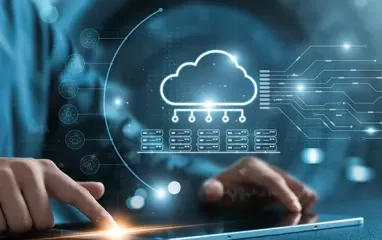Other recent blogs



Let's talk
Reach out, we'd love to hear from you!
The unprecedented rise in digital innovation and adoption has led to a sharp rise in something very undesirable - cybersecurity threats.
Cybercrime is expected to cost companies worldwide an estimated $23.82 trillion annually by 2027, up from $3 trillion in 2020.
However, this data is just the tip of the iceberg. Cyber attacks can turn into a disaster for less-prepared organizations.

It’s time to take Cybersecurity seriously
Despite the rising risks of cyber crimes, most organizations are still doing without effective security protocols and systems.
To keep people and IT assets safe and secure from rising cyber security threats, it is imperative for businesses to at least understand what are cybersecurity threats and implement common practices to keep their data and apps secure.
Here at Kellton, we take Cybersecurity very seriously. And we employ the following 7 layers to protect our people, processes, and technology from cyber-attacks.
7 layers of Cybersecurity
For Kellton, Cybersecurity is key to succeeding in today’s digital age - and it employs 7 different layers of cybersecurity to keep its employees, customers, and partners safe from cyber attacks.

1. Human layer
The human layer in Cybersecurity refers to the role that people play in the overall security of an organization. It acknowledges that humans are a crucial component of the Cybersecurity landscape, whether they are employees, contractors, or users.
At Kellton, we build and strengthen this human layer by empowering our workforce with continuous and carefully designed Cybersecurity programs and implementing strong policies emphasizing strong passwords and 2-factor authentication. This helps us safeguard our information assets from unauthorized access and intrusion.
A well-trained ecosystem of employees, customers, and partners, ensures that hackers find it increasingly difficult to break into our systems.
Our Cybersecurity technological solutions further boost the efficiency of our people and help them with threat identification and elimination.
2. Perimeter security layer
An essential component of our Cybersecurity strategy is the ‘perimeter security layer.’
This layer aims to protect the perimeter of our network of hardware and software systems and technologies. And we do it by keeping a tab on our incoming and outgoing traffic and thus ensuring that any malicious traffic is identified and blocked at its first instance.
Kellton employs leading-edge firewall solutions and a range of other security solutions to protect its network and keep its sensitive information and data safe and secure from unauthorized access and manipulation.
3. Network security layer
The network layer is responsible for protecting networks from unauthorized access and managing communication between devices and applications.
To secure and strengthen our networks, we employ leading-edge anti-malware and anti-virus to safeguard our network from bad actors.
By keeping our network secure, we ensure that only authorized parties or users have access to our critical assets and infrastructure.
A few common yet very effective network security measures include:
- Robust network architectures
- Access control
- Encryption
- Secure protocols
- Firewalls
- Network segmentation
- Intrusion detection system (IDS)
4. Application security layer
To mitigate Cybersecurity risks, Kellton practices secure coding - a practice to build applications where security is paramount right from the conceptualization stage. Our programmers are proficient in secure coding practices and thus develop apps that are not only secure but also reliable and scalable.
Effective application security measures also include:
- Web Application Firewalls (WAFs)
- Penetration testing and regular security scanning
- Cloud security
- Authorization
- Logging
5. Endpoint security layer
Endpoint security is the practice of protecting devices that connect to a network from being exploited by malicious actors and campaigns. These devices include computers, smartphones, tablets, servers, and virtual environments.
According to the International Data Corporation (IDC), 70% of successful cybersecurity breaches originate on endpoint devices. So, endpoint security is critical to keep your assets and data secure.
Here at Kellton, we secure our endpoints - such as our servers, desktops, laptops, and tablets - with the most robust security solutions and practices, such as antivirus programs.
By implementing strong endpoint security measures, we ensure our apps and the data they contain or transmit are protected from unauthorized access or cyber-attacks.
Here are some more ways to keep endpoints secure:
- Continuous vulnerability identification
- Continuous patch management
- Apply zero-trust practices
- Device control
- Data encryption
- And enforce the least privilege
6. Data security layer
Securing data is imperative for every organization across nearly every industry. And it’s true for us as well.
Within this layer, we adopt and practice an ever-expanding set of policies, technologies, and practices to keep our data protected from any kind of manipulation, whether external or internal.
Some of the measures we have adopted over the years include 1) Data encryption, 2) Frequent data backups so we never lose any sensitive or critical data, 3) Two-factor authentication, and 4) Enterprise right management and rules (ensuring data is erased when the device is no longer in use or is given to another employee.)
7. Mission-critical assets
This layer has been designed to secure our mission-critical assets. These critical assets comprise our databases, servers, and applications that we can not do without.
By deepening our understanding of the assets that are imperative to operating our business, we have built a layer that specifically takes care of these critical applications and systems.
To get started, you can:
- Identify your critical assets
- Assess their vulnerabilities
- Assess cloud security
- Access control
- Set up robust defense measures such as firewalls, intrusion detection and prevention systems
- Continuous updating and patching of applications
Securing your organization against common cybersecurity threats.
Protecting your people, partners, and digital assets is not that complicated. Often, you require careful planning and successful execution of that planning.
The journey toward building a secure and resilient organization can indeed be different for different organizations. However, every journey will have some common milestones. Here are some of them, and they will help you protect your organization and its critical assets from every possible attack or manipulation:
Use our checklist to ensure your organization does not fall prey to a cybersecurity threat:
- Skill up your workforce - An effective Cybersecurity program starts with employees. Host regular training sessions for your employees that cover email attacks, best practices, and alerting.
- Use strong passwords - Set enhanced password policies, automatic screen timeouts, limit user access, and encourage employees to refresh their passwords quarterly.
- Practice Multi-factor Authentication (MFA) - Implement MFA on your work and personal accounts. MFA can help keep your data secure, even if your password is compromised.
- Keep everything updated - Keep your applications and OS up to date. Routine patches protect your tech from vulnerabilities.
- Block spam email - Most cyber attacks start in your inbox. Protect your staff and intellectual property by implementing layered spam filtering.
- Data encryption - Secure your data by encrypting it at rest and in transit.
- Have a data backup plan - Backup your cloud and on-premise data, so your business can bounce back. And don’t forget to test those backups regularly.
- Regular security assessment - Establish a baseline for your cyber poster. When was your last assessment?
- Endpoint detection & response - Cover your hybrid and remote workers with endpoint detection solutions from malware, viruses, and script-based threats.
- Firewall protection - Find a firewall with intrusion detection and prevention features. You can also install firewalls that communicate with your SIEM to log files.
- SIEM/Log management - SIEMs track security events across your network. Protect your company against false alerts, and threats, and meet compliance requirements.
- Web gateway security - Internet security is a race against time. Cloud-based security solutions can track web threats as they emerge, blocking them before reaching your critical infrastructure.
- Mobile device security - Fortify your Cybersecurity capabilities by setting up mobile device security solutions.
Final note
It takes a lot of time and effort to heal from a data breach or any form of cyber security threat or attack. It can even take months - and this is not all. You stand to lose your customers’ trust, can get into legal trouble, and might lose a fortune.
So it makes perfect sense to invest in cybersecurity tools and technologies. However, the market of Cybersecurity is so massive that the first-timer might get overwhelmed with the sheer choices that are available.
Hiring a partner who understands the landscape of modern cybersecurity threats and has experience building and implementing new and cutting-edge security solutions can help significantly.
However, you can begin your journey with a few simple steps on your own - build secure applications (or hire someone like Kellton who does), empower your workforce and partners, implement data encryption technology, keep your endpoints secure, and continuously monitor your traffic.
To further explore the wide territory of cybersecurity and the new and forthcoming security threats, please connect with our experts here.



